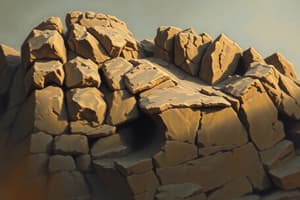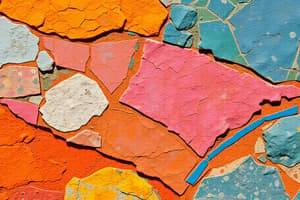Podcast
Questions and Answers
What does compositional maturity in sandstone primarily measure?
What does compositional maturity in sandstone primarily measure?
- Total mineral content in the rock
- Grain size distribution
- Color of the sandstone
- Proportion of stable minerals to unstable minerals (correct)
Which mineral is most abundant in sandstone with high maturity?
Which mineral is most abundant in sandstone with high maturity?
- Chert clasts
- Feldspar
- Lithic clasts
- Quartz (correct)
What classification of sandstone has more than 95% quartz?
What classification of sandstone has more than 95% quartz?
- Lithic sandstone
- Wacke
- Quartz arenite (correct)
- Arkosic sandstone
What is the defining feature of wackes in sandstone classification?
What is the defining feature of wackes in sandstone classification?
Which type of sandstone is characterized as mineralogically immature?
Which type of sandstone is characterized as mineralogically immature?
What is the significance of the matrix percentage in Pettijohn's classification?
What is the significance of the matrix percentage in Pettijohn's classification?
What process leads to the formation of clastic sediments from pre-existing rocks?
What process leads to the formation of clastic sediments from pre-existing rocks?
Which of the following is NOT considered a resistant mineral found in mature sandstone?
Which of the following is NOT considered a resistant mineral found in mature sandstone?
What does an increase in quartz content in sandstone imply about its maturity?
What does an increase in quartz content in sandstone imply about its maturity?
Which of the following is NOT a method of weathering mentioned in the context?
Which of the following is NOT a method of weathering mentioned in the context?
Which materials are primarily classified as siliciclastics?
Which materials are primarily classified as siliciclastics?
What is the process called that involves squeezing out water from sediments?
What is the process called that involves squeezing out water from sediments?
Which of the following environments is NOT a common site for sediment deposition?
Which of the following environments is NOT a common site for sediment deposition?
Which component is considered a biogenic sediment?
Which component is considered a biogenic sediment?
Which type of sediment is formed as a result of evaporite processes?
Which type of sediment is formed as a result of evaporite processes?
What type of minerals are clay minerals primarily categorized as?
What type of minerals are clay minerals primarily categorized as?
What primarily defines textural maturity in sandstones?
What primarily defines textural maturity in sandstones?
Which grain type is primarily associated with a mineralogically mature sandstone?
Which grain type is primarily associated with a mineralogically mature sandstone?
What does increasing sorting in sediment indicate about its maturity?
What does increasing sorting in sediment indicate about its maturity?
In the context of sediment transport, what does textural maturity provide clues about?
In the context of sediment transport, what does textural maturity provide clues about?
Which statement correctly describes arkose in terms of mineralogic maturity?
Which statement correctly describes arkose in terms of mineralogic maturity?
The Goldich Reaction Series primarily focuses on which aspect of minerals?
The Goldich Reaction Series primarily focuses on which aspect of minerals?
What happens to feldspar grains during sediment transport over time?
What happens to feldspar grains during sediment transport over time?
How is the roundness of grains related to sediment maturity?
How is the roundness of grains related to sediment maturity?
What characteristic structure do clay minerals share that contributes to their perfect cleavage?
What characteristic structure do clay minerals share that contributes to their perfect cleavage?
Which of the following describes detrital sedimentary rocks?
Which of the following describes detrital sedimentary rocks?
What defines the difference between conglomerate and breccia?
What defines the difference between conglomerate and breccia?
What do the terms monomict, polymict, and diamict refer to in sediment categorization?
What do the terms monomict, polymict, and diamict refer to in sediment categorization?
Which of the following environments are sandstone typically associated with based on their grain sizes?
Which of the following environments are sandstone typically associated with based on their grain sizes?
What range of grain sizes defines sandy sediments?
What range of grain sizes defines sandy sediments?
What is the main difference between ortho conglomerates and para conglomerates?
What is the main difference between ortho conglomerates and para conglomerates?
Which of the following is NOT a product of weathering?
Which of the following is NOT a product of weathering?
Flashcards are hidden until you start studying
Study Notes
The Rock Cycle
- Sedimentary rocks cover a larger proportion of the land surface.
- They are primarily created through weathering, erosion, and deposition of pre-existing rocks.
Clastic Sedimentary Rocks
- Formed from clastic sediments resulting from the weathering and erosion of existing rocks.
- Weathering can occur physically (e.g., freeze-thaw) or chemically.
- Erosion transports sediments via water, wind, and ice before they settle in various environments such as deserts, oceans, rivers, or lakes.
Sediment to Rock Transformation
- Lithification involves:
- Compaction, which squeezes out water.
- Diagenesis, leading to the precipitation of cements that bind sediments.
Mineralogy
- Clastic sediments consist of siliciclastics (quartz, feldspars, clay minerals) and calciclastics (calcite, dolomite).
- Biogenic sediments form as biochemical or inorganic chemical precipitates (e.g., shelly fragments in limestones).
- Chemical sediments include evaporates (halite, gypsum, anhydrite) produced through evaporation processes.
Clay Minerals
- Main components include kaolinite, smectite, illite, chlorite, and micas, formed in water presence.
- Characterized by a planar structure similar to micas, resulting in unique physical properties.
Primary vs. Residual vs. Dissolved Products
- Primary minerals (e.g., feldspar, quartz) transform into residual minerals (e.g., clay) or dissolved ions (K+, Ca²+, Na+).
Detrital and Chemical Sediments
- Detrital sediments categorized by grain size, including conglomerates, breccias, sandstones, and shales, characterized by clastic textures.
- Chemical and biochemical sediments include materials produced through evaporation or chemical reactions.
Grain Size Classification
- Utilizes the Udden-Wentworth scale, categorizing sediments into gravel, sand, mud, and clay based on grain size.
Conglomerates and Breccias
- Conglomerates consist mainly of rounded clasts, while breccias feature angular clasts.
- Clast types, such as monomict, polymict, and diamict, define the rock type and granule composition.
Sandstone Characteristics
- Sandstones comprise grains with modal sizes between 2mm and 0.063mm and consist mainly of quartz, feldspar, and lithic fragments.
- Diagenetic cements include crystalline forms such as quartz and calcite.
Maturity of Sandstones
- Textural maturity reflects grain roundness and sorting, while mineralogical maturity indicates quartz concentration against less resistant minerals.
- Mature sandstones are well-rounded, well-sorted, and contain a higher percentage of quartz.
Goldich Reaction Series
- Compares weathering trends with temperature against crystallization trends emphasizing mineral stability and decay.
Pettijohn Classification System
- Classifies sandstones based on matrix percentage, distinguishing between matrix-poor (wackes) and other forms.
Porosity and Depth Interpretation
- Increasing quartz content signifies increased maturity in siliciclastic rocks, influencing porosity and formation characteristics.
Summary of Detrital Sedimentaries
- Detrital sedimentary rocks showcase variations in composition and grain size, influencing overall rock classification and characteristics.
Studying That Suits You
Use AI to generate personalized quizzes and flashcards to suit your learning preferences.




